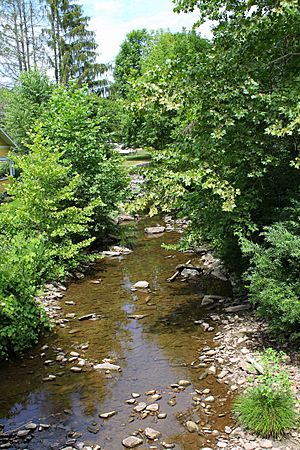Horton Creek (Tunkhannock Creek tributary) facts for kids
Quick facts for kids Horton Creek |
|
|---|---|

Horton Creek looking downstream
|
|
| Physical characteristics | |
| Main source | pond in Brooklyn Township, Susquehanna County, Pennsylvania between 1,480 and 1,500 feet (451 and 457 m) |
| River mouth | Tunkhannock Creek in Nicholson, Wyoming County, Pennsylvania 715 ft (218 m) 41°37′02″N 75°47′39″W / 41.6172°N 75.7942°W |
| Length | 11 mi (18 km) |
| Basin features | |
| Progression | Tunkhannock Creek → Susquehanna River → Chesapeake Bay |
| Basin size | 16.9 sq mi (44 km2) |
| Tributaries |
|
Horton Creek is a cool stream, about 11 miles (18 km) long, in Pennsylvania. It flows through Susquehanna County and Wyoming County. This creek is a tributary (a smaller stream that flows into a larger one) of Tunkhannock Creek.
The area around Horton Creek is mostly countryside with not many people living there. You can find several lakes and a swamp in the creek's watershed (the land area that drains water into the creek). The land here is quite "rough and hilly."
People started settling near Horton Creek in the early 1800s. Long ago, industries like quarries (where rocks are dug up), sawmills (for cutting wood), and farming were important here. The creek was also used to supply water to nearby towns. Today, Horton Creek is a great place for fishing and is known for its cold water, perfect for trout.
Contents
Where Horton Creek Flows
Horton Creek starts in a pond in Brooklyn Township, Susquehanna County. It flows south for a short distance, even crossing Pennsylvania Route 167. Then, it turns southeast and gets water from a smaller stream joining it from the right.
The creek continues flowing southeast, passing through another pond and a wetland (a marshy area). More small streams join it along the way. It then enters Lathrop Township.
After winding through Lathrop Township, the creek enters Nicholson Township in Wyoming County. It flows south, sometimes along the border of the town of Nicholson. Finally, Horton Creek reaches the end of its journey, crosses Pennsylvania Route 92, and joins Tunkhannock Creek.
Water and Weather
Horton Creek is considered a healthy waterway. This means it's not listed as a polluted or "impaired" body of water.
On average, the area around Horton Creek gets about 35 to 40 inches (89 to 102 cm) of rain and snow each year.
Land and Rocks Around the Creek
The land around Horton Creek is quite interesting. Near where the creek joins Tunkhannock Creek, the ground is about 715 feet (218 meters) above sea level. The very beginning of the creek is much higher, between 1480 and 1500 feet (451 to 457 meters) above sea level.
The ground near the creek's mouth is mostly made of alluvium (silt, sand, and gravel left by flowing water) and a type of till (rocky material left by glaciers). Right next to the creek, you'll mostly find alluvium. The valley itself has a lot of till. You might also see small areas of wetlands and bedrock made of sandstone and shale. There are even small piles of broken sandstone from old quarries.
A book from 1921 described the land around Horton Creek as "rough and hilly." The creek's valley is quite narrow, surrounded by hills that were smoothed out by glaciers long ago. The creek itself has a winding path and flows over sandstone and material left behind by glaciers.
Horton Creek's Watershed
The watershed (the area of land that drains into the creek) of Horton Creek covers about 16.9 square miles (43.8 square kilometers). The creek's mouth is in the town of Nicholson.
Most of the watershed is in northeastern Wyoming County and southern Susquehanna County. It's mainly rural, meaning it's mostly countryside with few towns. There are several lakes and swamps in the watershed, including Lakeside Pond and Lord Pond.
Horton Creek is important for aquatic life (plants and animals that live in water). Several companies have received permits related to construction near the creek, ensuring they control erosion and protect the water quality.
History and Fun Facts
Horton Creek was officially added to the Geographic Names Information System in 1979.
Early settlers like Elisha Smith and Josiah Pratt arrived near Horton Creek in 1811. The valley of the creek was even considered as a possible route for a railroad long ago.
In the early 1900s, the main jobs in the Horton Creek area were working in quarries, sawmills, and agriculture. The creek was also a source of water supply for the town of Nicholson. The Nicholson Water Company had a reservoir on the creek. In 1959, the town was allowed to take even more water from the creek for its residents.
Several bridges cross Horton Creek. A concrete bridge carrying State Route 2096 was built in 1940. Other bridges were built in the 1960s, including one for Pennsylvania Route 92 in 1969.
Horton Creek is a great spot for fishing! In 1998, it was called an "excellent" place for angling (fishing with a rod and line).
Creek Life
Horton Creek's watershed is designated as a Coldwater Fishery and a Migratory Fishery. This means it's a good habitat for cold-water fish, and fish that travel to different waters can also use it.
The creek has been stocked with trout. In 2014, rainbow trout were added to the creek from State Route 3023 downstream to its mouth, making it an even better place for fishing!


